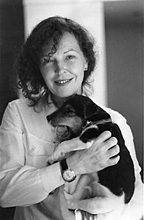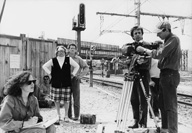Juror
Dominique Auvray
 [Juror’s Statement]
[Juror’s Statement]
I have been the editor of Jacques Rivette le veilleur and Man No Run, two documentaries by Claire Denis; Where Does Your Hidden Smile Lies? and In Vanda’s Room by Pedro Costa; Notebook on Cities and Clothes by Wim Wenders; and Koko, A Talking Gorilla by Barbet Schroeder. I worked on feature films as well with each of these filmmakers, and I see no difference between In Vanda’s Room and The Truck by Marguerite Duras.
The way I thought about the editing process was the same: to search the material (“offered” by reality or made by artifacts), to find what it hid and to help it free from its shell. The raw material is, for me, the first cut following the story for a feature film, and for a documentary film, the choice upon the rushes that enlightens the story. Then, and only then, the same deconstruction process begins. We tear, we listen, we watch in order to see deeper and to find the film—if it exists.
As a director, I did a so-called documentary. I shot very little as Marguerite was dead already. I chose to organize a portrait with her body, her voice, her thoughts through archives which I tore, stretched and cut, and which gave me the feature material of my memory and friendship; keeping in mind colors, emotions and mediums, in order to make a movie as musically as possible.
I do not follow the fight: ‘Feature’ vs. ‘Documentary’. For me, there are good films and bad films, no matter which category they belong to. A good film is a film that creates Cinema, which gives news of the world and its emotions. Cinema gives more weight, clarity and reality to the world it creates, a world which does not come from nowhere.
“A documentary is a feature film of which the script is written after the shooting.”—Frederick Wiseman
Dominique Auvray began her career after meeting with Marguerite Duras and becoming the editor for Duras’ films Baxter, Vera Baxter (1976), The Truck (1977) and Le Navire Night (1978). She has also edited the works of such radical filmmakers as Philippe Garrel, Wim Wenders, Claire Denis and Pedro Costa. In 2002 she made, as a director, a portrait of Marguerite Duras, writer and filmmaker. The film has since been screened at a number of film festivals including the Locarno International Film Festival. She is currently planning a documentary on Japanese pillow books (makura-e). |
Marguerite As She Was
Marguerite, telle qu’en elle-même. Un portrait FRANCE / 2002 / French / Color, B&W / Video / 61 min
FRANCE / 2002 / French / Color, B&W / Video / 61 min
Director, Editing, Source: Dominique Auvray
Photography: Pascal Marti, Andre Chemetoff
Sound: Regis Muller, Nathalie Vidal
Music: Jean-Christophe Marti, Carlos d’Alessio
Song, Reading of Duras’ texts: Jeanne Balibar
Producer: Chantal Bernheim
Production Companies: Dune, INA, Arte France
On June 3, 1991, Marguerite Duras gave me a copy of her latest book The North China Lover. It was dedicated for the first time, and she wrote, “To my friend Dominique Auvray to remember a marvel among all: the one from a recent past: when we were working together making Cinema.”
This portrait is to come close to her, as she was: cheerful and serious, true and provocative, attentive and categorical, but above all young and free.
—Dominique Auvray
